Day 10 – Last day in Paris. Exploring Montmartre and the Museum Fragonard at the Veterinary School.
(Continued from Day 9)
For the last day, I figured we should take the obligatory trek to Montmartre.
It’s a trendy neighborhood, and it has so much history. So many struggling artists, poets dreamers and drinkers came here for the cheap rent and wild nightlife.
The Metro takes you to Rue des Abbesses, where you encounter the rust-red Neo-Gothic Saint-Jean-de-Montmartre church. It was built in the early 20th century.
Nearby was Le Cafe Qui Parle, with their popular weekend all-you-can-eat buffet brunch.
After brunch, a walk through the quaint little streets, until you get to where everyone is heading, the Place du Tertre.
The Place du Tertre has been the town square of the small village of Montmartre since medieval times. It is lined with cafes, shaded by acacia trees, and filled with artists, hucksters, and loads of tourists. An even mixture of charm and kitsch.
Just yonder is the neighborhood’s main attraction, Sacré-Cœur Basilica. It took 44 years to build this thing. It stands on a foundation of 83 pillars that were sunk 130 feet deep. This was necessary because the ground beneath contained gypsum mines. The exterior, in fact, is laced with gypsum, which gets whiter with age.
oNormal>The Metro takes you to Rue des Abbesses, where you encounter the rust-red Neo-Gothic Saint-Jean-de-Montmartre church. It was built in the early 20th century.

With its onion domes and bleached pallor, it looks ancient, however, it was finished only a century ago by Parisian’s humiliated by German invaders. Otto von Bismarck’s Prussian army laid siege to Paris for more than four months in 1870. Things got bad. Really bad. People had to cook up dogs, cats, and finally rats, just to survive. Convinced they were being punished for the country’s liberal sins, France’s Catholics raised money to build the church as a way to get back in the Lord’s good graces. Because, you know, he really digs big buildings. Plus, building the church was a kind of penitence by the French. Many friend citizens were digested that in 1871, their government actually shot their own citizens, the Communards, who held out here on Montmartre after the French leadership surrendered to the Prussians. (Check out my blog post on the Pere Lachaise cemetery. It contains a nice photo of the Communards’ monument.)
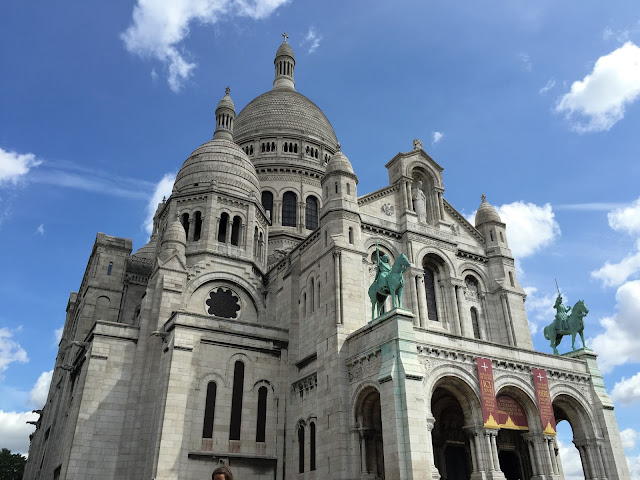
The view from the steps of Sacre Cœur is amazing. It’s Paris’ highest natural point (420 feet).
and everyone congregates on the steps of the church to hang out and enjoy the view.
The inside of the church is pretty overwhelming. No photos were allowed, supposedly, but of course, with everyone having a cell phone, you can’t enforce the no-camera rule very much these days. Everyone was blatantly taking photos.
The nave is what everyone comes to see, because above it is an impressive mosaic high above the altar.
It’s a 60 foot tall Christ, exposing his “sacré cœur” (sacred heart), burring with love and compassion for humanity. Joining him is a dove representing the Holy Spirit and God the Father high above. Christ is flanked by biblical figures on the left (including St. Peter, kneeling) and French figures on the right (a kneeling Joan of Arc in her trademark armor).
There are other French figures in the mosaic: clergymen, government leaders (in business suits), and French saints (including St. Bernard, with his famous dog, and St. Louis, with his crown of thorns.)
At the base of the mosaic is the National Vow of the French people begging God’s forgiveness:
“Sacritissimo Cordi Jesu Gallia Poenitens et devota” which means, “To the Sacred Heart of Jesus, we are penitent and devoted.”
By tradition, there is, right now in the church, at least one person praying for Christ to be understanding of the world’s sins. It’s been going on 24/7, since the construction was completed. We saw something similar in Istanbul: a mosque where people work in shifts so that someone is constantly reading the Quran aloud 24/7, non-stop.
After visiting the Basilica, we explored a few different streets in the neighborhood before heading to the Metro. Here’s a cliche shot of a guy playing the accordion.
There was a really nice crafts shop with colorful sculptures of dogs, snails, and other creatures, all for absolutely ridiculous prices.
And, as in every neighborhood, street art was everywhere. I liked this Monsanto soup can.
I ended our trip with a visit to a museum that I had wanted to visit for a while. The Musée Fragonard d’Alfort, usually just referred to as the Musée Fragonard. It’s a museum of anatomical oddities within the École National Veterinaire deMaisons-Alfort. It was cool seeing a veterinary school in another country.
It was a long Metro ride to the veterinary school, which is in a suburb (Maisons-Alfort) of Paris. On the grounds when you walk in is this statue of Claude Bourgelat, the founder of the veterinary school.
The Fragonard Museum was built in 1766 and is one of the oldest French museums in existence. The museum opened to the public in 1991 and today consists of three rooms containing a large collection of mutations and dissections, most of which date from the 19th and 20th centuries.
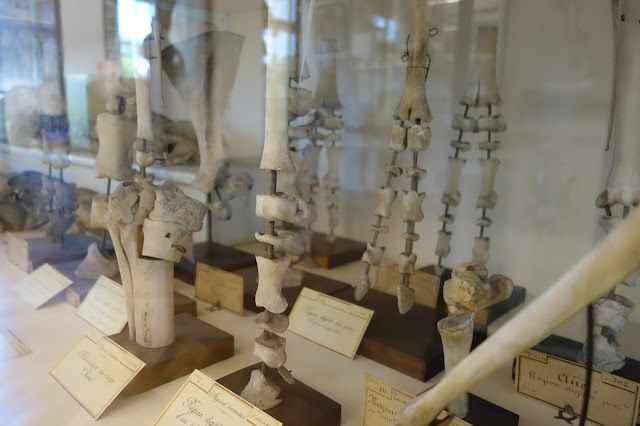

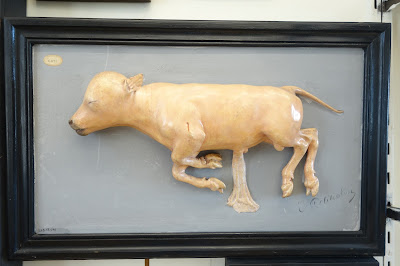
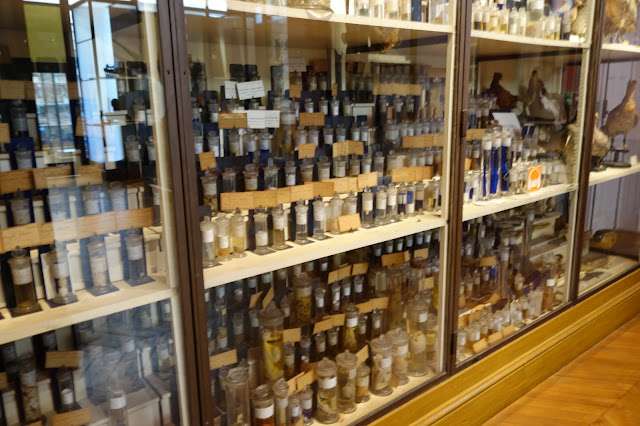
In addition to all sorts of skeletons and dissections, there is a substantial collection of monstrosities, so to speak. Things like Siamese twin lambs, two headed calfs, cyclops animals, etc.
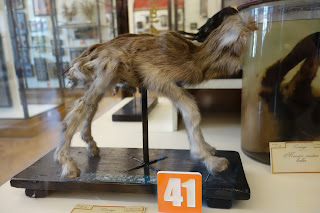
The most notable items are the famous “écorchés” or flayed figures prepared by Honoreé Fragonard, the school’s first professor of anatomy. His specialty was the preparation and preservation of skinned cadavers. He prepared some 700 examples. Only 21 remain. All are on display in the last room of the museum.

I like skeletons, and they had a pretty extensive collection.
I found the place fascinating and couldn’t get enough of it. After the museum, we headed back to our hotel in the Marais. I passed that street near the cat cafe, and once again saw that cat that I saw yesterday, just watching the happenings on the street. This cat has life all figured out – a nice viewing spot in a great neighborhood in a spectacular city. I wouldn’t mind trading places with him.
Hope you enjoyed the travelogue. Upcoming trips include Oslo, Norway at the end of the summer, and Myanmar (!) in the fall. If I see kitties on either of those trips, you’ll be the first to know.























